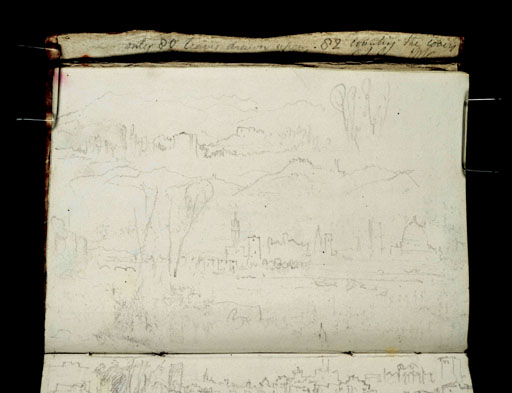Joseph Mallord William Turner Florence, from near Ponte S. Niccolò 1828
Image 1 of 2
Joseph Mallord William Turner,
Florence, from near Ponte S. Niccolò
1828
Folio 2 Verso:
Views of Florence, from the San Niccolò District 1828
D21415
Turner Bequest CCXXXIII 2a
Turner Bequest CCXXXIII 2a
Pencil on white lined wove paper, 96 x 144 mm
Accepted by the nation as part of the Turner Bequest 1856
References
1909
A.J. Finberg, A Complete Inventory of the Drawings of the Turner Bequest, London 1909, vol.II, p.714, CCXXXIII 2a, as ‘Two views of town, with distant mountains’.
1984
Cecilia Powell, ‘Turner on Classic Ground: His Visits to Central and Southern Italy and Related Paintings and Drawings’, unpublished Ph.D thesis, Courtauld Institute of Art, University of London 1984, pp.302 note 25, 433.
1987
Cecilia Powell, Turner in the South: Rome, Naples, Florence, New Haven and London 1987, pp.[139], 206 note 18.
This page marks the first appearance in the sketchbook of Florence, a location that is particularly well represented; in total, twenty-two pages feature views of the city: see also folios 3 recto, 8 verso, 17 verso, 18 recto, 38 verso, 39 recto, 44 recto, 66 recto, 71 recto and verso, 74 recto, 76 verso and 77 recto to 80 recto (D21416, D21427, D21445–D21446, D21487–D21488, D21497, D21538, D21546–D21547, D21552, D21556–D21565).
Other major cities to appear in this sketchbook namely Genoa, Pisa and Livorno, were visited by Turner for the first time in 1828. By comparison, Florence was more familiar to the artist, with direct implications for his sketching practice. As Cecilia Powell has observed, Turner first depicted the city in around 1818, when he executed three watercolours for James Hakewill’s Picturesque Tour of Italy (developed from Hakewill’s own drawings), and he visited Florence in person on the return leg of his journey from Rome in 1819.1 Turner’s ‘main study of the city and its environs’ occurred in 1819, when he compiled notes on various paintings in the Uffizi and elsewhere, and visited the Duomo, the Basilica of Santa Croce, and other Florentine churches.2 On this earlier visit, see Nicola Moorby’s introduction and entries in the present catalogue for the Rome and Florence sketchbook (Tate; Turner Bequest CXCI). Before his second major tour of Italy, in around 1827, Charles Heath commissioned Turner to make a watercolour of Florence to be engraved in his new annual, The Keepsake.3 The viewpoint Turner selected for this watercolour, Florence, from San Miniato (Herbert Art Gallery and Museum, Coventry), was near the hilltop Abbey of San Miniato al Monte, south of the River Arno, a site he revisited in the autumn of 1828.
During his 1828 visit to Florence, Turner eschewed close-up studies of buildings in favour of panoramic vistas from the city’s periphery. He sought out spots along the banks of the River Arno to the east, or from elevated hillside positions in the southern Oltrarno district, near the Church of San Salvatore al Monte, the present-day Piazzale Michelangelo and the Abbey of San Miniato al Monte. From these various vantage points, he rediscovered views ‘that he was obviously delighted to see again’, Powell observed.4 As noted by Nicola Moorby, a further contrast between the two tours concerns the distribution of Turner’s sketches. In 1819, his views of Florence were concentrated within a single book, the Rome and Florence sketchbook. In 1828, by comparison, they were spread sparingly across two, the Genoa and Florence and Florence to Orvieto sketchbooks.5
Here, turning the sketchbook horizontally, Turner layered two views of Florence on one page. As Powell identified, the dominant lower vista depicts the city from the east; Turner’s vantage point was near the present-day Ponte San Niccolò, facing north-west from the south bank of the Arno.6 The domes and towers of the city’s distinctive skyline are traced in the distance, with the fourteenth-century Torre di Arnolfo, part of the Palazzo Vecchio, forming a central focal point. The view terminates to the right with an outline of Giotto’s campanile and Brunelleschi’s dome, forming the Duomo complex. To the left are two medieval bridges: the Ponte alle Grazie, destroyed in 1944 and subsequently reconstructed, and just visible beyond it the Ponte Vecchio. Framing and partially obstructing the view are two bending trees in the foreground, a reminder of Turner’s riverside vantage point.
The minor view spanning the top of the page is less densely populated with buildings, and a precise location is difficult to identify. Turner was possibly sketching from a similar position in San Niccolò but facing south or east towards the outskirts of the city.
These views of Florence are out of sequence with the overall itinerary embodied by the sketchbook (see the Introduction), which begins near Genoa and ends near Livorno and Florence.
Hannah Kaspar
November 2024
Cecilia Powell, ‘Florence’, in Evelyn Joll, Martin Butlin and Luke Herrmann (eds.), The Oxford Companion to J.M.W. Turner, Oxford 2001, p.111.
Ian Warrell, Turner: The Fourth Decade: Watercolours 1820–1830, exhibition catalogue, Tate Gallery, London 1991, pp.66–7 under nos.79–80.
How to cite
Hannah Kaspar, ‘Views of Florence, from the San Niccolò District 1828’, catalogue entry, November 2024, in David Blayney Brown (ed.), J.M.W. Turner: Sketchbooks, Drawings and Watercolours, Tate Research Publication, February 2025, https://www


